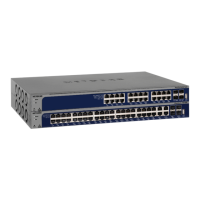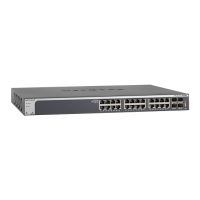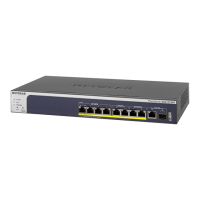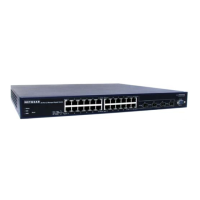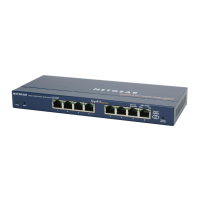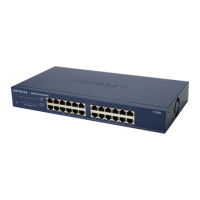Configure Switching
167
XS708T, XS712Tv2, and XS716T Smart Managed Pro Switch User Manual
IGMP Snooping
Internet Group Management Protocol (IGMP) snooping is a feature that allows a switch to
forward multicast traffic intelligently on the switch. Multicast IP traffic is traffic that is destined
to a host group. Host groups are identified by class D IP addresses, which range from
224.0.0.0 to 239.255.255.255. Based on the IGMP query and report messages, the switch
forwards traffic only to the ports that request the multicast traffic. This prevents the switch
from broadcasting the traffic to all ports and possibly affecting network performance.
A traditional Ethernet network can be separated into different network segments to prevent
placing too many devices onto the same shared media. Bridges and switches connect these
segments. When a packet with a broadcast or multicast destination address is received, the
switch forwards a copy to each of the remaining network segments in accordance with the
IEEE MAC Bridge standard. Eventually, the packet is made accessible to all nodes
connected to the network.
This approach works well for broadcast packets that are intended to be seen or processed by
all connected nodes. In the case of multicast packets, however, this approach could lead to
less efficient use of network bandwidth, particularly when the packet is intended for only a
small number of nodes. Packets are flooded into network segments where no node is
receptive to the packet. While nodes rarely incur any processing overhead to filter packets
addressed to unrequested group addresses, they cannot transmit new packets onto the
shared media for the period of time that the multicast packet is flooded. The problem of
wasting bandwidth is even worse when the LAN segment is not shared, for example in
full-duplex links.
Allowing switches to snoop IGMP packets is a creative effort to solve this problem. The
switch uses the information in the IGMP packets as they are being forwarded throughout the
network to determine which segments receive packets directed to the group address.
Configure IGMP Snooping
You can configure the parameters for IGMP snooping, which is used to build forwarding lists
for multicast traffic.
To configure IGMP snooping:
1. Connect your computer to the same network as the switch.
You can use a WiFi or wired connection to connect your computer to the network, or
connect directly to a switch that is off-network using an Ethernet cable.
2. Launch a web browser.
3. In the address field of your web browser, enter the IP address of the switch.
If you do not know the IP address of the switch, see Change the Default IP Address of the
Switch on page 10.
The login window opens.
4. Enter the switch’s password in the Password field.
The default password is password.

